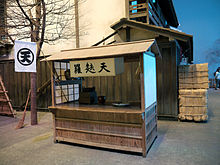Tempura
Tempura (天ぷら or 天麩羅, tenpura, [tempɯɾa]) is a typical Japanese dish that usually consists of seafood and vegetables that have been coated in a thin batter and deep-fried.
Tempura originated in the 16th century, when Portuguese Jesuits brought the Western-style cooking method of coating foods with flour and frying, via Nanban trade.
[10] Thin slices or strips of vegetables or seafood are dipped in the batter, then briefly deep-fried in hot oil.
[16] Kakiage is a type of tempura made with mixed vegetable strips, such as onion, carrot, and burdock, and sometimes including shrimp or squid, which are deep fried as small round fritters.
[citation needed] However, toward the end of the 16th century, the technique of fritter-cooking with a batter of flour and eggs was acquired in Nagasaki by Portuguese missionaries.
[19] Peixinhos da horta was a dish often eaten during Lent or Ember days to fulfill the fasting and abstinence rules for Catholics.
[22] In the early 17th century, around the Tokyo Bay area, tempura ingredients and preparation changed as the yatai (food cart) culture gained popularity.
Making the best use of fresh seafood while preserving its delicate taste, tempura used only flour, eggs, and water as ingredients, and the batter was not flavored.
As the batter was mixed minimally in cold water, it avoided the dough-like stickiness caused by the activation of wheat gluten, resulting in the crispy texture now characteristic of tempura.
Serving deep-fried food indoors was prohibited during Edo because tempura oil was a fire hazard in Japanese buildings, which were made of paper and wood.
[23][24] The idea that the word "tempura" may have been derived from the Portuguese noun tempero, meaning a condiment or seasoning of any kind, or from the verb temperar, meaning "to season" is also possible as the Japanese language could easily have assumed the word tempero as is, without changing any vowels as the Portuguese pronunciation, in this case, is similar to the Japanese.
[25] There is still today a dish in Portugal very similar to tempura called peixinhos da horta, "garden fishes", which consists of green beans dipped in a batter and fried.
[citation needed] Today, particularly in western Japan, the word "tempura" is also commonly used to refer to satsuma-age, fried surimi fish cake which is made without batter.
[citation needed] A variation is to use panko (breadcrumbs), which results in a crisper consistency than tempura batter, although in Japan this would be classified as a furai dish.
In Bangladesh, the blossoms of pumpkins or marrows are often deep-fried with a gram of rice flour spice mix, creating a Bengali-style tempura known as kumro ful bhaja.











